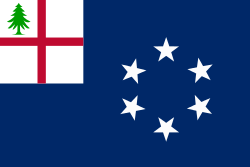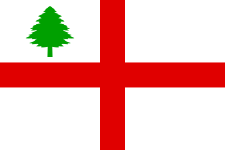There is no official Flag of New England. Consequently, "the Flag of New England" can refer to any number of historical and modern banners used to represent Massachusetts, the New England Colonies, or the six states in the New England region of the United States. There are some variations, but common designs include a plain colored field (usually red) with a pine tree in the canton. Pinus strobus, the eastern white pine, is the most common symbol of New England and most often represents that tree's former importance in shipbuilding and New England maritime culture.
History
Most New England flags were based on the red naval ensign or blue naval ensign of the Royal Navy, which featured the cross of St. George in the canton. The ensign was used at both the Jamestown and Plymouth colonies. Puritans in New England, led by Roger Williams, objected to the use of a Christian cross on their flag, and for a time flew a red flag with a plain white canton.[1] The new flag first appeared in 1634 in Salem, but some considered it to be an act of rebellion against England. Opinion was sought from England, and the cross was retained on crown property, such as Castle Island.[2] The crossless flags became popular in New England, and militia companies designed unique patterns on their flags. In 1665, the Royal Commissioners recommended that all ships and militia companies be ordered to fly "the true colours of England, by which they may be knowne to be his majesties legittmate subjects."[3] Nevertheless, some crossless flags were still in use as late as 1680.
New Englanders continued to look for ways to represent their country, however. In 1684, the town of Newbury, Massachusetts, though retaining the Cross of St George, changed to a green flag.[3] A pine tree was added to some flags during the reign of King James II, possibly inspired by the pine-tree shilling which was minted in Massachusetts.[3] In 1707, a proclamation was issued that all merchant vessels fly the red ensign with the British Union Flag in the canton. To insure compliance, a woodcut was published in the Boston News-Letter on 26 January 1707 - the first illustration printed in an American newspaper.[4]
Some controversy exists concerning which flag flew at the Battle of Bunker Hill in 1775, at the onset of the American Revolutionary War. An officer of the Royal Marines reported that no flags were used by the rebels.[5] John Trumbull, known for his paintings of the war, used a red flag with a pine tree in his 1786 painting The Death of General Warren at the Battle of Bunker's Hill, June 17, 1775.[6] However, he later painted another version of this painting for the family of the fallen general, which depicts a blue flag.[7] (Another flag commonly used to represent the battle has a blue flag with a white canton, the canton quartered with cross of St. George (the symbol of England) with a tree in the first quarter of the canton.) Although possibly inspired by the Blue Ensign of the Royal Navy, the blue field is said to have been due to an error in a wood engraving, causing confusion among painters.[1] (This could have been caused by incorrect "hatching", whereby parallel lines represent heraldic "tinctures" or colors: horizontal lines represent "blue," while vertical ones represent "red.")[8] However, Benson John Lossing writes in Field Book of the Revolution that he interviewed the daughter of a Bunker Hill veteran who told her that he hoisted a blue flag on Breed's Hill prior to the battle.[9] Regardless of its authenticity, the blue variation has become a symbol of the Battle of Bunker Hill, and as such Charlestown (the neighborhood encompassing Bunker and Breed's hills) and was featured on a 1968 US Postage Stamp.
Historical flags
| Flags of New England |
|---|
| The First Flag (and Ensign) of New England, used by Colonial merchant ships sailing out of New England ports, 1686-c.1737. [11][12] |
| The blue Bunker Hill Flag. As noted above, the blue field may be the result of an error in a wood engraving; the actual "Bunker Hill Flag" may have been the red First Flag (and Ensign) of New England, also pictured here. |
|
Modern flags

Flag adopted by the New England Governors' Conference in 1998
On June 8, 1998, K. Albert Ebinger of Ipswich, Massachusetts made a presentation to the New England Governor's Conference (NEGC) promoting the adoption of the flag at right the official flag of the NEGC.[14] The flag is the blue "Bunker Hill Flag" defaced with six five-pointed stars in a circle made to represent the six New England states. It was copyrighted by Ebinger in 1965, and remains under copyright.[15] The NEGC, without realizing it was under copyright by Mr. Ebinger, adopted the design. In response to a letter of concern subsequently written by the New England Vexillological Association, the New England Governors' Conference wrote, in part, "In 1998, Mr. Ebinger appeared before the New England Governors' Conference, in Fredericton, New Brunswick, Canada during the annual Conference of New England Governors and Eastern Canadian Premiers and suggested the promotion of New England tourism would benefit from the use of a common symbol, such as his 'New England Flag'. At that meeting, the governors approved a motion to adopt the flag as the 'official emblem of the New England Conference'. They did not make any claims as to its legitimacy as an official or authentic flag of the six state region, nor did they adopt it as the official flag of the region."[16]
See also
References
- 1 2 Mastai, pg 16
- ↑ Furlong, 39
- 1 2 3 Furlong, 40
- ↑ Furlong, 42
- ↑ Furlong, 68
- ↑ "The Death of General Warren at the Battle of Bunker's Hill". americanrevolution.org. Retrieved 13 March 2015.
- ↑ "Boston Museum of Fine Arts - The Death of General Warren at the Battle of Bunker's Hill, 17 June, 1775". mfa.org. Retrieved 2 January 2015.
- ↑ https://www.google.com/search?q=heraldic+hatching&tbm=isch&tbo=u&source=univ&sa=X&ei=_SqmVKCVAYafgwTtmIGACw&ved=0CC0QsAQ&biw=1920&bih=918
- ↑ Lossing, Chapter 23, endnote 19
- ↑ Edward O’Connor. "Alternate flags for New England". E. O’Connor. Retrieved 2008-01-29.
- 1 2 David B. Martucci. "The New England Flag". D. Martucci. Archived from the original on April 1, 2007. Retrieved 2008-07-25.
- 1 2 'Historical Flags of Our Ancestors'. "Flags of the Early North American Colonies and Explorers". Loeser.is. Retrieved 30 October 2014.
- ↑ "New England flags (U.S.)". Crwflags.com. Retrieved 2008-11-07.
- ↑ "The Flag of New England Page". Midcoast.com. Archived from the original on April 1, 2007. Retrieved 30 October 2014.
- ↑ Archived February 2, 2009, at the Wayback Machine.
- ↑ "The New England Flag by David B. Martucci". Archived from the original on April 1, 2007. Retrieved 14 March 2015.
Works cited
- Furlong, William Rea; McCandless, Byron (1981). So Proudly We Hail : The History of the United States Flag. Washington, D.C.: Smithsonian Institution Press. ISBN 0-87474-448-2.
- Lossing, Benson J. (1850). Pictorial Field Book of the Revolution.
- Mastai, Boleslaw; Mastai, Marie-Louise D'Otrange (1973). The Stars and the Stripes. The American Flag as Art and as History from the Birth of the Republic to the Present. New York: Alfred A. Knopf. ISBN 0-394-47217-9.
External links
|
|---|
|
| Topics | |
|---|
|
| States | |
|---|
|
| Major cities | |
|---|
|
| State capitals | |
|---|
|
| Transportation | | Passenger rail |
- MBTA (MA, RI)
- Northeast Corridor (CT, MA, RI)
- Acela Express (CT, MA, RI)
- Downeaster (ME, NH, MA)
- Vermonter (CT, MA, NH, VT)
- Shore Line East (CT)
- Metro-North (CT)
- High-speed Northern New England (proposed)
|
|---|
| | Major Interstates |
- I-84 (CT, MA)
- I-89 (NH, VT)
- I-90 (Mass Pike) (MA)
- I-91 (CT, MA, VT)
- I-93 (MA, NH, VT)
- I-95 (CT, RI, MA, NH, ME)
|
|---|
| | Airports | |
|---|
|
|---|
|
-
 Category Category
-
 Portal Portal
|






